
Wellington station is a Massachusetts Bay Transportation Authority (MBTA) Orange Line rapid transit station in Medford, Massachusetts, near the border of Everett. It is located on the Revere Beach Parkway, slightly east of its intersection with Route 28. Wellington functions as a park and ride with more than 1,300 spaces, and a bus hub with 10 routes terminating at the station. The Station Landing development, connected to the station by an overhead walkway, includes residential and retail buildings and additional parking. Wellington Carhouse, the primary repair and maintenance facility for the Orange Line, is located adjacent to the station.
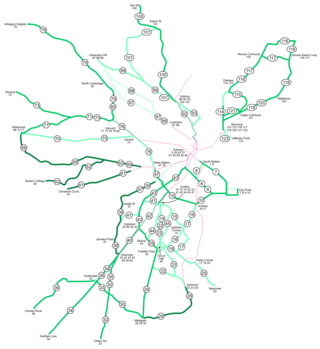
As with many large cities, a large number of Boston-area streetcar lines once existed, and many continued operating into the 1950s. However, only a few now remain, namely the four branches of the Green Line and the Ashmont–Mattapan High-Speed Line, with only one running regular service on an undivided street.

The Fitchburg Railroad is a former railroad company, which built a railroad line across northern Massachusetts, United States, leading to and through the Hoosac Tunnel. The Fitchburg was leased to the Boston and Maine Railroad in 1900. The main line from Boston to Fitchburg is now operated as the MBTA Fitchburg Line; Pan Am Railways runs freight service on some other portions.

The Fitchburg Cutoff was a rail line running 2.8 miles (4.5 km) from Brighton Street in Belmont, Massachusetts, to Somerville Junction in Somerville, Massachusetts. It was constructed in two segments in 1870 and 1881 to connect the Lexington Branch and Central Massachusetts Railroad to the Boston and Lowell Railroad. Passenger service lasted until 1927. Freight service ended in 1979–80 to allow construction of the Red Line Northwest Extension; the line was abandoned in three sections in 1979, 1983, and 2007.
The Lexington and West Cambridge Railroad was a railroad company chartered in 1845 and opened in 1846 that operated in eastern Massachusetts. It and its successors provided passenger service until 1977 and freight service until 1980 or early 1981.

Silver Hill station was an MBTA Commuter Rail Fitchburg Line station in Weston, Massachusetts, United States. The station had a small shelter, parking area, and a gravel boarding area; it was not accessible. It was the least-used station in the entire MBTA system in 2018, with an average of just eleven daily boardings. Silver Hill station opened in 1844 as one of the original stops on the Fitchburg Railroad. The Boston and Maine Railroad unsuccessfully attempted to close the station in 1959. It remained in use until its temporary closure by the Massachusetts Bay Transportation Authority (MBTA) in December 2020 due to low ridership and a lack of accessibility, with indefinite closure effective April 2021.

Attleboro station is a commuter rail station on the MBTA's Providence/Stoughton Line located in Attleboro, Massachusetts. By a 2018 count, Attleboro had 1,547 daily riders, making it the fourth busiest station on the system outside Boston.

Andover station is an MBTA Commuter Rail station in Andover, Massachusetts. It serves the Haverhill Line. The station has one platform with a mini-high platform for handicapped accessibility serving one track, while the second track lacks a platform. The previous station building, used from 1907 to 1959, is still extant; it was added to the National Register of Historic Places in 1982 as Third Railroad Station.

West Concord station is an MBTA Commuter Rail station located in West Concord, Massachusetts. It is served by the Fitchburg Line. The station has two side platforms serving the line's two tracks, with mini-high platforms for accessibility. The adjacent station building, now a restaurant, is not used for railroad purposes.

Medford/Tufts station is a light rail station on the Massachusetts Bay Transportation Authority (MBTA) Green Line located off Boston Avenue near College Avenue in Medford, Massachusetts, adjacent to Tufts University. The accessible station has a single island platform serving the two tracks of the Medford Branch. It opened on December 12, 2022, as part of the Green Line Extension (GLX), which added two northern branches to the Green Line, and is the northern terminus of the E branch.
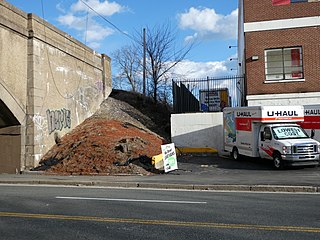
Mystic Valley Parkway station is a proposed light rail station on the MBTA Green Line in Somerville, Massachusetts; it would be built as part of a future third phase of the Green Line Extension (GLX). Route 16 would consist of one island platform, which would serve the E branch's two tracks.

Ball Square station is a light rail station on the Massachusetts Bay Transportation Authority (MBTA) Green Line located at Ball Square in Somerville and Medford, Massachusetts. The accessible station has a single island platform serving the two tracks of the Medford Branch. It opened on December 12, 2022, as part of the Green Line Extension (GLX), which added two northern branches to the Green Line, and is served by the E branch.
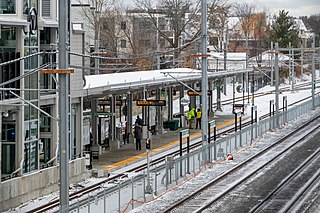
Magoun Square station is a light rail station on the Massachusetts Bay Transportation Authority (MBTA) Green Line located at Lowell Street south of Magoun Square in Somerville, Massachusetts. The accessible station has a single island platform serving the two tracks of the Medford Branch. It opened on December 12, 2022, as part of the Green Line Extension (GLX), which added two northern branches to the Green Line, and is served by the E branch.

Gilman Square station is a light rail station on the Massachusetts Bay Transportation Authority (MBTA) Green Line located at Gilman Square in Somerville, Massachusetts. The accessible station has a single island platform serving the two tracks of the Medford Branch. It opened on December 12, 2022, as part of the Green Line Extension (GLX), which added two northern branches to the Green Line, and is served by the E branch.

East Somerville station is a light rail station on the Massachusetts Bay Transportation Authority (MBTA) Green Line located in southeastern Somerville, Massachusetts. The accessible station has a single island platform serving the two tracks of the Medford Branch. It opened on December 12, 2022, as part of the Green Line Extension (GLX), which added two northern branches to the Green Line, and is served by the E branch.
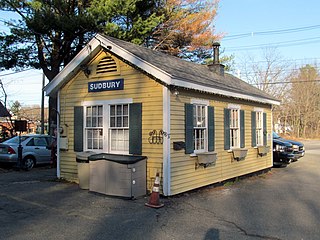
South Sudbury was a commuter rail station in Sudbury, Massachusetts. It was located at the junction of the Central Massachusetts Railroad and the Framingham and Lowell Railroad slightly north of Boston Post Road in South Sudbury. The Boston and Maine Railroad station was incorporated into the MBTA Commuter Rail through subsidies in 1965. The station was closed in November 1971 when the branch's last remaining round trip was discontinued. The 1952-built station building was a private business until its closure in 2019, and the building is now abandoned. In August 2023 the Massachusetts Department of Conservation and Recreation offered the building to the Town of Sudbury at no cost.

Lake Street station was a commuter rail station on the Lexington Branch, located in the East Arlington section of Arlington, Massachusetts. The line opened as the Lexington and West Cambridge Railroad in 1846, with a station at Pond Street among the earliest stops. It was renamed Lake Street in 1867. The Boston and Lowell Railroad (B&L) acquired the line in 1870 and built a new station building in 1885. Service continued under the Boston and Maine Railroad (B&M) – successor to the B&L – though it declined during the 20th century. Lake Street station and three others on the line were closed in May 1958. The Massachusetts Bay Transportation Authority (MBTA) began subsidizing service in 1965, and Lake Street station reopened in March 1968. All passenger service on the Lexington Branch ended on January 10, 1977; it was converted into the Minuteman Bikeway in the early 1990s.
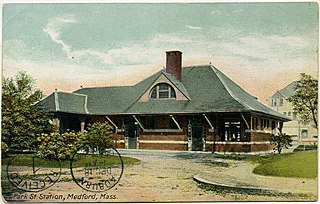
The Medford branch was a railroad branch line of the Boston and Maine Railroad (B&M). Located entirely within Medford, Massachusetts, the branch connected Medford Square to the B&M main line. It had passenger service from 1847 to 1957, with freight service on the inner part of the line until 2010.

Winchester Highlands station was an MBTA Commuter Rail Lowell Line station located at Cross Street in the northern part of Winchester, Massachusetts. It originally opened in the mid-19th century under the Boston and Lowell Railroad (B&L) as a flag stop called North Winchester. In 1877, a local real estate developer constructed a new station building, which was renamed Winchester Highlands. The B&L became part of the Boston and Maine Railroad (B&M) in 1887. Service to the station gradually decreased in the 20th century, and the depot was replaced by a wooden shelter around 1943. The Massachusetts Bay Transportation Authority (MBTA) began subsidizing service on the line in 1965. Winchester Highlands and two other stations with low ridership were closed by the MBTA in June 1978.
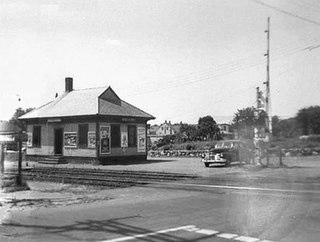
Cross Street station was an MBTA Commuter Rail station in northern Winchester, Massachusetts, on the border with Woburn. The station first opened in the mid-1840s as Richardson Row on the Woburn Branch Railroad, part of the Boston and Lowell Railroad (B&L). It was renamed Cross Street in 1876. The Boston and Maine Railroad (B&M) leased the B&L in 1887, built a new depot at Cross Street in 1893, and replaced it with a concrete shelter in 1955. The Massachusetts Bay Transportation Authority (MBTA) began subsidizing service on the Woburn Branch in 1965 and purchased the line in 1976. The station was closed along with the Woburn Branch in 1981.





















